|
Winding on smooth or flat faced drums The first layer must be wound tight and under tension. Take a mallet or a piece of wood and tap the wraps tightly against each other (see picture 1); but not so tight that the rope strands interlock (see picture 2), but tight enough that the rope can’t be shifted on the drum. If the first layer is wound too loose, the next layer will wedge a gap into the first layer causing that layer to ‘pull in’ (see picture 3). A too tightly wrapped first layer will not allow the next layers enough space between wraps (see picture 2). In any case, the first layer, as well as all of the layers, must be wound on to the drum with sufficient pre-tension (5-10% of the rope’s WLL is a good measure). If wound with no tension at all, the rope is subjected to premature crushing and flattening caused by the ‘under load’ top layers (see picture 4). Even if wound on properly during installation, the first layer will loosen somewhat during service. When the first layer becomes slack (the pre-tension is gone), this initial procedure MUST be repeated in regular intervals. Otherwise, the tensioned ‘hard’ wraps will severely crush the bottom layers (picture 5). |
Winding on grooved drums If the first layer, or layers, are only used from time to time, they will loose their tension on the drum and start to flatten out due to the high pressures of the loaded layers. Repeat this pre-tensioning procedure regularly. As with tower cranes, for example, which have a long rope length installed and rise as the building goes up, pre-tensioning will not be possible. In these cases it may be advisable to install a shorter rope length first. Otherwise, you may have to replace the entire rope length because of crushing and flattening of the bottom layers. If this not possible, extra care must be taken to pre-tension the rope on the drum during installation. Whatever you do, DO NOT run the rope through a ‘tightening’ device (see picture 6), e.g. two wooden blocks clamped together. YOU WILL DESTROY |
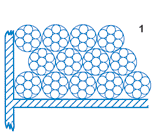 |
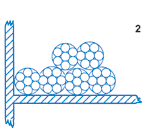 |
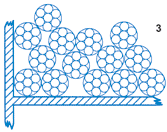 |
| Proper winding on drum. Rope does not interlock and has enough pre-tension not to damage the bottom layers. | Rope wraps have been tapped too much together. Note the resulting strand interlocking. The rope will get damaged. | Rope wraps have gaps on first layer. Note that the top layers will not spool properly. The rope “pulls in”. |
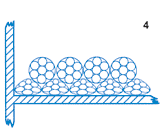 |
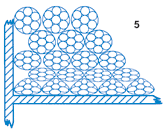 |
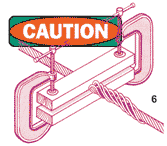 |
| Bottom layer was not wound on the drum with enough tension. This layer will get crushed by the top layer when loaded to WLL. | Layers were not unspooled and pre-tensioned during service. Bottom layers will flatten out by the load imposed by the top windings. | This method of tightening the rope on to the drum WILL destroy the rope. |
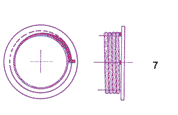 |
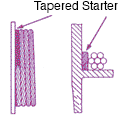 |
|
| This tapered lifter provides a ramp for the rope to ride up the flange to prevent wedging the rope against the flange and adjacent wraps. |



